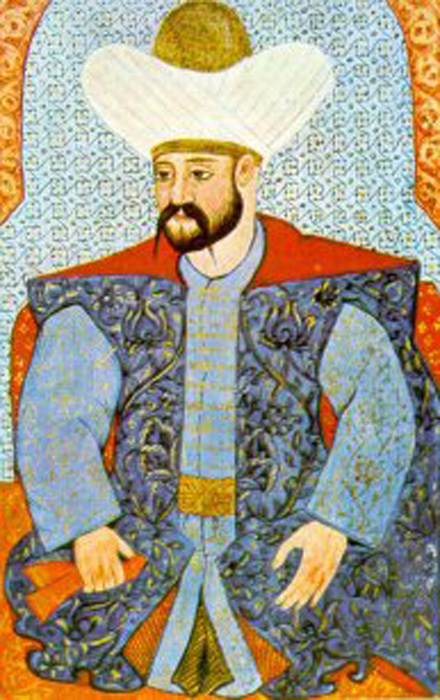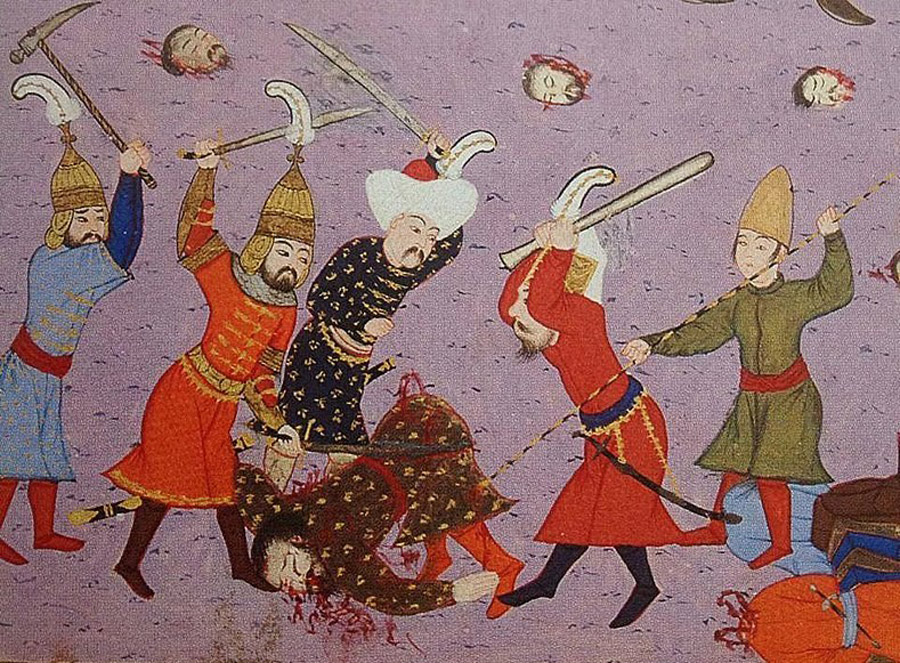The legend of Milos Obilić has a long tradition in the histories of both Serbia and the Ottoman Empire. Whilst he is not mentioned in contemporary sources, he features prominently in later accounts of the Battle of Kosovo between the Serbs and the Ottomans, as the assassin of Sultan Murad.
It is difficult to reconstruct anything of what happened that day, but it seems that after a bloody and brutal encounter which left both armies shattered, Prince Lazar, leader of the Serbs, was captured or killed. Sultan Murad and Lazar would both lose their lives that day, with the sultan apparently surprised and murdered away from the fighting.
Whilst the evidence for the assassination is slim at the time, the story quickly spread across the 15th century, appearing in Florentine, Serbian, Ottoman, and Greek sources. The multiple, apparently independent sources would seem to suggest that the story was true.
But there have been questions as to this story, and whether Milos Obilić ever even existed. He is reputed to have been in the service of Lazar in the 14th century. Lazar’s family looked to strengthen their political control in this period and as such, it has been suggested that they may have given birth to a unifying myth of Kosovo, which includes the story of Obilić.
The story has taken on national significance, and he is classed as one of the most notable national heroes of medieval Serbian folklore. Obilić has even been venerated as a saint in the Serbian Church. But was any of it real?
Earliest Sources
The earliest sources on the Battle of Kosovo focus more on Prince Lazar and do not mention Milos or his supposed assassination of the sultan. The record of the assassination appears to come from Deacon Ignjatije on the 9th of July 1389, only 12 days after the battle.

Sultan Murad and one of his sons are also mentioned by the Venetian Senate in their instructions to their emissary Andrea Bembo a couple of weeks later. The Bosnian king Tvrtko I (1353-1391) wrote a letter to the town of Trogir to inform the citizens of the town that the Ottomans had been defeated.
- Was King Arthur Real? Examining the Historical Record
- Abu Bakr II: Did the King of Ancient Mali go to America?
The victory over the Turks was also reported by the Chancellor of Florence Coluccio Salutati, who wrote to the Bosnian king on behalf of the Florentine Senate. Whilst the killer is not named, he is described as a Christian nobleman who broke through the Ottoman ranks and managed to get to the tent of Sultan Murad.
It was not until the Italian traveler and merchant Mignanelli’s 1416 work, decades later, that the killer is named. But even here it is not Milos Obilić who is credited with killing Murad, with Mignanelli instead that it was Lazar who committed the deed, killing the sultan with a concealed dagger when brought before him.
The assassin’s first appearance in Serbian sources comes from Lazar’s son Stefan Lazarevic’s biography by Constantine the Philosopher, some eighty years later in the 1440s. The hero of this version is described as a man who was of noble birth who sought to prove his loyalty by killing the sultan.
According to this text. he feigned desertion and snuck up on the sultan and stabbed him to death before being himself killed shortly afterward. This is similar to a Greek version of events, which may suggest an element of truth to this account.
Greek and Ottoman Sources
The loss of the sultan featured far more prominently in the earliest Ottoman sources. In stark contrast to the western sources they describe Murad, unaccompanied on the battlefield, being cut down by a Christian who had been lying concealed among the corpses. This story was echoed again in the 15th century, with the Ottoman poet Ahmed repeating this story and perhaps using the same source.
One of the most influential sources comes from the work of Enveri, who was a 15th-century poet and historian. Modern historians have claimed that this account may have been based on eyewitness testimony from the battle.
It is not clear who exactly would have provided this detailed information to Enveri. One such person could be Hoca Omer, an envoy sent by the sultan to Lazar before the battle. However, crucially, this Ottoman account also mentions Milos.
In this source, before Milos became a Serbian nobleman, he was a Muslim at the court of Sultan Murad. He deserted the sultan and renounced Islam, leaving the sultan was distraught and hoping for his return, which never came.
During the battle, after Lazar had been captured, Milos is said to have called forth to the sultan saying that he wished to return to the Islamic faith and the sultan’s service. However, when he approached the sultan, Milos stabbed Murad with a dagger hidden in his cuff, killing him before the Ottoman guard had time to stop him. Milos was then cut to pieces.

In Greece in the late 15th century, an Athenian scholar by the name Laonicus Chalcocondyles claims to draw on earlier Greek traditions. In these stories, Milos is a nobleman who was outfitted by Lazar and approached the sultan under the guise of a deserter. This is repeated by Michael Doukas in his Historia Byzantia which was written in the late 15th century.
The deception aspect of the story is therefore often repeated, which may suggest it has some truth to it. However historians have claimed that this was an element introduced by the Turkish sources to show the duplicity of the Christian faith, having to rely on devious methods to win.
Serbian Legend
In Serbian memory, the myth of Milos Obilić has become central to Kosovo mythology particularly in the 19th century. Writers who visited the cities of Serbia in the 19th century recorded that the fervor for this myth and cult, noting that it was as if the Battle of Kosovo had taken place yesterday. It was during this period that Milos Obilić became a saint.
The history of this myth was given a further boost when Petar II Perovic-Njegos, the Archbishop of Montenegro wrote the epic poem The Mountain Wreath in 1847. Along with this he also instituted the Obilić medal that was given for outstanding courage. These were used throughout the Balkan wars, WWI and WWII, further tying the legend to Serbia’s national identity.
Milos Obilić: Real or Fake?
The story of Milos Obilić is a great case study for much of medieval literature and the historian’s preference of a “great man”. The chroniclers of Milos may have been so keen to find a hero that whether he existed hardly matters. The story has been used to build up national sentiment and patriotism effectively and has provided writers across time with a heroic and villainous character.

There is a potential that in the Serbian army at Kosovo there was a man named Milos who may have killed the sultan. Ultimately, he could be used as a powerful message and has been effectively used in this way. In fact, despite questions of his authenticity he is still included on the list of 100 most prominent Serbs, where he ranks at number 10.
Top Image: The story of Milos Obilić is one of several accounts of the death of Sultan Murad. Source: Diter / Adobe Stock.
By Kurt Readman